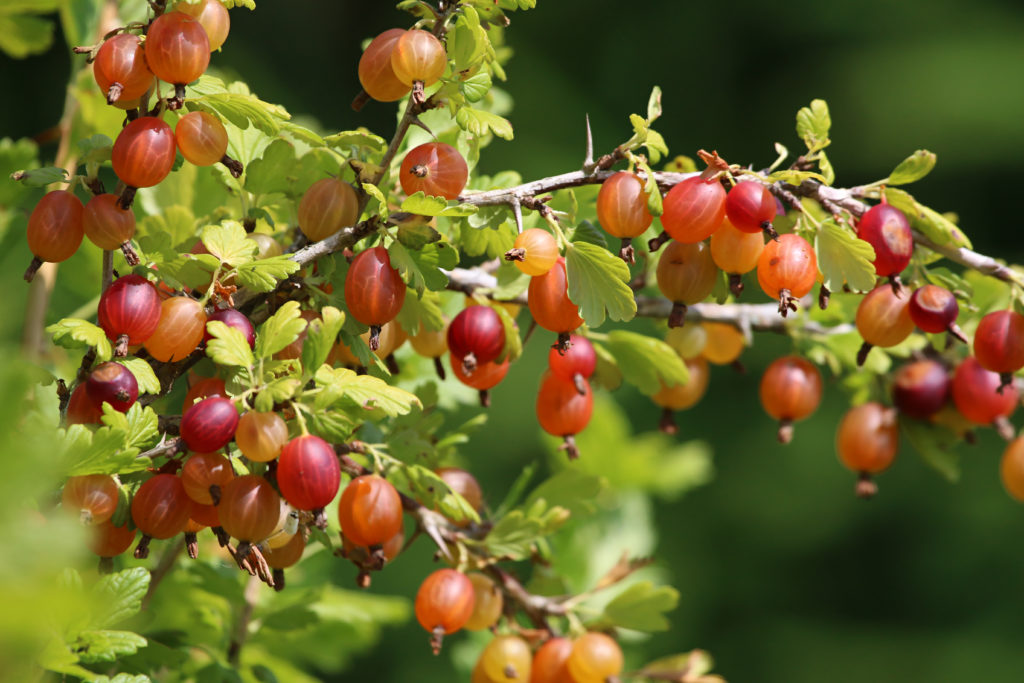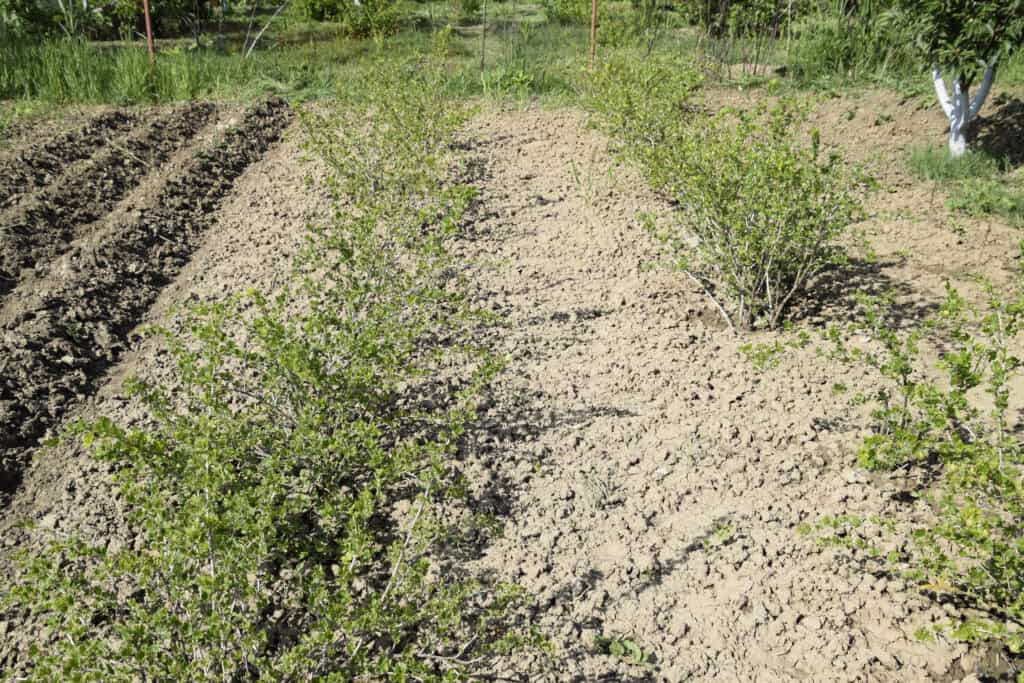Gooseberries are small, round thin-skinned fruits that look a lot like grapes. Ripe gooseberries can be green, pink, yellow, or white. Some gooseberry varieties are for fresh-eating and desserts; others are for cooking—pies, tarts, jam, jellies, and sauces; and some varieties can be used both fresh and cooked.
The gooseberry is a hardy, deciduous, perennial shrub that grows 4 to 5 feet tall. Gooseberries grow best in cool-summer regions; in winter gooseberries will benefit from temperatures cold enough to freeze the top few inches of soil. There are varieties that will grow in slightly warmer regions.

Here is your complete guide to growing gooseberries.
Where to plant gooseberries
- Gooseberries grow best in cool-summer climates.
- Plant gooseberries in full sun. In hot regions, grow gooseberries in partial shade. Grown in partial shade the berry yield will be reduced.
- Plant gooseberries out of a prevailing breeze or wind. Do not plant gooseberries in low spots where frost can settle.
- Plant gooseberries in slightly acidic soil; a soil pH of 6.0 to 6.5 is optimal. Gooseberries will tolerate slightly alkaline soil and average garden soil.
- Do not plant gooseberries in waterlogged soil.
- Add aged compost or commercial organic planting mix to planting beds; gooseberries grow best in well-drained soil.
- The gooseberry can carry a disease called white pine blight. In regions where white pines grow, gooseberry planting has been controlled in the past. Check with the nearby Cooperative Extension Service to see if gooseberries are commonly grown in your area.
Spacing gooseberries
- Space gooseberry bushes 4 to 5 feet apart.
- Space rows 5 feet apart.
- Gooseberries trained to a stake (cordon) or wire can be planted as close as 2 feet apart.
- One gooseberry plant will yield about 10 pounds of fruit each year.

How to plant gooseberries
- Plant bare-root gooseberries in spring as soon as the soil can be worked or in fall. Gooseberries leaf out in spring; it’s best to plant before they leaf out. Gooseberries can withstand temperatures as low as 20°
- Plant container-grown gooseberries in spring or summer; avoid planting them in hot dry weather.
- Dig a hole half again as deep at the root ball and twice as wide; moisten the hole before planting. Make a small mound at the bottom of the hole and spread out the roots of the plant so that they run off the mound.
- Plant gooseberries level with the soil mark of the nursery pot or just a bit deeper. Backfill the hole with half-native soil and half-aged compost or commercial organic planting mix. Firm in the soil to be sure no air pockets remain around the roots.
- Cut back all but 5 or 6 shoots to the ground after planting.
- Water the new plant with a high phosphorus liquid starter fertilizer.
- Keep the soil evenly moist as the plant begins to grow.
Gooseberry pollination
- Gooseberries are self-pollinating.
Container growing gooseberries
- Plant gooseberries in pots at least 18 inches wide and deep; gooseberry roots grow wide, not deep. Plant gooseberries in an organic potting mix.
- Keep the soil evenly moist; feed plants an all-purpose fertilizer that is slightly high in potassium.
- Re-pot gooseberries each autumn after harvest; trim roots as necessary to avoid becoming root-bound.
Watering and feeding gooseberries
- Keep gooseberries well-watered; do not let the soil dry out; irregular watering can cause gooseberry fruit skins to crack as they develop or near harvest.
- Feed gooseberries an all-purpose fertilizer that is slightly high in potassium in spring. During the growing season side-dress gooseberries with a dilute solution of fish emulsion.
- Avoid high-nitrogen fertilizers; nitrogen will increase green growth at the expense of fruit growth.
How to care for gooseberries
- Keep gooseberry planting beds free of weeds; mulch planting beds with aged compost or commercial organic planting mix to keep down weeds.
- Protect gooseberries from birds that will eat the buds in spring and the fruit in summer; place bird netting over plants to exclude birds.
- Gooseberries are hardy but it’s still a good idea to protect new spring foliage and flowers from frost by placing row covers over the plants.
How to prune gooseberries
- During the first two years, prune gooseberries to create an open, vase-like structure. An open structure will allow sunlight and air to reach the interior of the plant and ripen berries.
- In the first year, select 3 to 5 main stems that grow away from the leader (main stem) in opposite directions. Cut each back by half. Remove other smaller branches and stems as well as those that are broken or crossing. Create an open vase-like form, an open center. When pruning stems, cut just above an outward-facing bud; new branches will grow outward, not inward.
- In the second year select 3 to 5 more stems growing away from the leader and allow these to grow on while again pruning away stems that are growing inward. By the third summer, you will have 9 to 15 stems sturdy stems growing out from the center; these will be your main flowering and fruiting stems.
- In the third year going forward, prune back about a quarter of each main stem and continue to prune away new growth growing inwards; also prune away suckers growing from the base of the plant. During the summer prune all new side shoots so that there are just 5 leaves on each.
- At the end of each season of the first three seasons keep 3 to 5 of the best shoots. In the fourth year, remove the stems from the first year, the oldest stems, and keep 3 to 5 of the best new young stems; each following year trim away the oldest wood and renew the plant by selecting the best of the new stems.
- Gooseberries fruit on older wood; to keep gooseberries productive, cut back young stems and side shoots.
How to train gooseberries
- Gooseberries can be trained to a cordon or stake. Train the leader upward and tie it in at one-foot intervals. Prune side shoots in summer so that they have just 5 leaves; in winter prune side shoots so that there are one or two buds facing outwards.
Gooseberry diseases and pests
- Gooseberries can be a host to blister rust, a disease that can seriously affect white pine trees. If white pines grow in your regions, check with the nearby Cooperative Extension Service to see if planting gooseberries is controlled.
- Powdery mildew and leaf spots can attack gooseberries; spray the foliage with a fungicide or a solution of 1-part baking soda and 9-part water.
- Leaves that brown or dieback may be attacked by the fungus botrytis; trim dieback off immediately.
- Curled leaves may be a sign of aphids; check the undersides of leaves and knock aphids off plants with a steady stream of water.
- Leaves with brown curled edges that look scorched yellow can be a sign of potassium deficiency in the soil.
- Leaves that turn yellow between the veins (called chlorosis) can be a sign of a magnesium or iron deficiency.
- Orange or red blisters on leaves can be a sign of the fungal disease rust. Trim away these leaves and spray the plant with a fungicide or compost tea.
- Gray or brown mold on fruits is a sign of botrytis or another fungal disease; this can also cause leaf dieback. Remove affected fruits and prune to encourage greater air circulation.
- Cracked skin on fruit can be a sign of irregular watering or birds attacking. Keep the soil evenly moist and exclude birds with netting.
- Leaves that are eaten may be a sign of caterpillars. Control imported currant worm and gooseberry fruitworm with a rotenone/pyrethrin mix; control currant borer by cutting off the stem just below the borer entry hole.
Fall and winter gooseberry care
- Feed gooseberries a moderate amount of nitrogen and a high amount of potassium and magnesium in late winter.
- Thin gooseberry stems and branches in winter. See pruning instructions above.

Harvesting gooseberries
- The first crop will come in the second season after planting.
- Gooseberries for cooking should be harvested slightly underripe. Gooseberries for fresh eating or desserts should be allowed to ripen fully on the bush.
- Gooseberries develop full flavor only when they are left to ripen on the bush. Ripe gooseberries will be full-colored.
- The harvest of one plant will last five to six weeks.
- Harvest thorny-stemmed gooseberries by holding a branch up with one gloved hand and picking or sliding your other gloved hand down the stem letting berries fall into a container. It’s best to wear heavy leather gloves; the thorns are prickly.
- Keep harvested berries out of direct sunlight.
Storing and using gooseberries
- Gooseberries are often eaten raw with milk and sugar or cooked in pies, tarts, jams, and jellies.
- Gooseberries will keep in the refrigerator for two or three weeks.
Propagating gooseberries
- Gooseberries can be propagated by tip layering or hardwood cuttings.
- Bend a low-hanging shoot with at least 3 buds to the ground in mid-summer and hold it in place with a garden staple or rock. Cover the stem with soil; the shoot will root in a year’s time and the new plant can be cut away from the parent.
- Take hardwood cutting in fall; strip the cutting off all but the newest leaves and roots in an organic potting mix.
Gooseberry varieties to grow
- Gooseberries are classified as culinary or dessert varieties; dessert varieties are sweet and can be eaten fresh; culinary varieties are sour when can be cooked with sugar to make jams, jellies, and pies. There are some varieties good for both fresh eating and cooking.
- Tasty red gooseberries include ‘Pixwell’, ‘Poorman’; ‘Pixwell’ is easy to harvest because the berries hang away from the thorns.
- Dessert or fresh-eating varieties include ‘Achilles’, ‘Hinnomaki Yellow’, ‘Langley Gage’, ‘Captivator’.
- Gooseberry varieties that can be used for culinary and dessert or fresh eating include ‘Greenfinch’, ‘Lancashire Lad’, ‘Leveller’, ‘Hinnonmaki Red’, ‘Hinnomaki Yellow’, ‘Careless’, ‘Invicta’, ‘Whinhams’ Industry’, ‘Martlet’, ‘Remarka’, ‘Pax’, ‘Xenia’.
- Disease-resistant varieties include ‘Poorman’, “Leepared’, ‘Welcome’.
- Old-time favorite varieties are “Downing’, ‘Oregon Champion’, ‘Red Jacket’, ‘Poorman’.
Related articles:
Planning the Home Fruit Garden
Garden Planning Books at Amazon:
- Vegetable Garden Almanac & Planner
- Kitchen Garden Grower’s Guide Vegetable Encyclopedia
- Vegetable Garden Grower’s Guide
- Tomato Grower’s Answer Book
More fruit-growing articles:
Learn how to plant, grow, prune, and harvest your favorite fruits. Click below for all you need to know.
- Apple
- Apricot
- Avocado
- Banana
- Blackberry
- Blueberry
- Cantaloupe
- Chayote
- Cherimoya
- Cherry
- Citrus
- Clementine
- Cranberry
- Currants
- Elderberry
- Feijoa
- Fig
- Gooseberry
- Grape
- Grapefruit
- Guava
- Kiwifruit
- Kumquat
- Lemon
- Lime
- Loquat
- Mandarin
- Mango
- Melon
- Mulberry
- Muskmelon
- Nectarine
- Olive
- Orange
- Papaya
- Passion Fruit
- Peach
- Pear
- Persimmon
- Pineapple
- Pineapple Guava
- Plantain
- Plum
- Pomegranate
- Pumpkin
- Quince
- Raspberry
- Strawberry
- Tangelo
- Tangerine
- Tangor
- Watermelon



